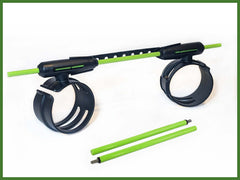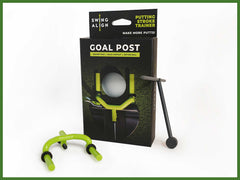How to Hit a Draw in Golf
No one likes to hit a slice. Practically every golfer has sought advice on how to draw a golf ball like many professionals do, instead of hitting a slice. Luckily a few simple changes can help you straighten out your ball flight and increase your distance off the tee at the same time. This article will focus on the draw and what it can do for your game.
- What is a Draw?
- Hitting a Draw with a Driver
- Hitting a Draw with Irons
- Practice Hitting Draws with Swing Align
What is a Draw in Golf?
Let’s start with a quick definition. For right-handed players a draw in golf is a ball flight that moves slightly right-to-left in a controlled manner, or slightly left-to-right for left-handers. A draw is the opposite of a fade ball flight, which moves slightly left-to-right for right-handers. If a draw goes too far or too quickly right-to-left for a right-handed player, it is called a hook, which is the opposite of a slice. Assuming you don’t hit the ball dead straight, you should always aim to hit a draw or a fade as they are the most controllable ball flights. Let’s discuss the proper setup and process for hitting a draw.
How to Hit a Draw with a Driver
The basic fundamentals of a golf swing that produces a draw ball flight are consistent through the bag, but there are a few differences you need to keep in mind when hitting a driver vs. an iron. The driver is the longest club in the bag with the least amount of loft so controlling the direction of the clubface is critical.
- Control the clubface: To hit a draw, you need to make sure your clubface doesn’t open too much during your golf swing. As soon as the face gets open, it is very difficult to maneuver it back to square. An open club face increases the amount of sidespin at impact which produces too much curve and in most cases a slice. To hit a draw you want a square clubface at impact with a slightly inside-to-square club path. Your grip plays a big role so be sure that your top hand is more on top of the club and your bottom hand is square to slightly underneath the club. An easy way to check your grip is to cock your wrists up and see if the V’s formed by your thumb and forefinger are pointed up at your trail shoulder. If not, you can strengthen your grip by slightly rotating your hands clockwise if you are right handed.
- Keep it square on the backswing: Your clubface needs to be square at impact and on the right path in order to hit a draw. That process starts by ensuring the clubface stays square during your backswing. Try to feel as though the clubface points at the ball as long as possible on the takeaway. Be sure to rotate the club back with your arms and body, not your hands. Staying connected helps you get to the top of your swing without manipulating the clubface. At the top of your swing the ideal hitting position is with the wrist on your top hand flat and in line with your forearm, not cupped, bowed or bent too much.
- Use your hips: As you rotate, turn your body into your trail hip and keep your rear end back. You should feel weight on the inside of your trail leg and on the heel of your back foot. Be sure to turn your trail hip away from the ball as well and keep your spine angle and posture steady. This strong position will give you enough room to make an aggressive turn into the ball and give your arms enough room to return in the correct position to attack the ball from the inside instead of moving out and over the top.
- Swing inside-to-out: A draw is created with an inside-to-out golf swing. In order to make that kind of move into the golf ball, you must be on the right club path. Assuming you have kept the clubface square and rotated back properly, you will be able to drop the club inside and attack the “inside” of the golf ball. Visualize hitting the ball at 4pm on the clock dial. This will create the inside-to-square club path and proper draw spin on the ball at impact.
- Finish strong: It is very important that you make an aggressive follow through to hit a draw. If you decelerate into the ball, and into your follow through by extension, you will likely alter your clubface or path. Drive through to the finish rotating your chest to face the target.
- Stay connected: Keeping your arms and body in sync during the swing and using your big muscles is critical. Most golfers tend to use their arms and hands too much to deliver the club to impact. Use a Swing Align device to help you stay connected to deliver the club with more power and accuracy.
How to Hit a Draw with Irons
Many of the steps for how to hit a draw with an iron are similar to those required for hitting a draw with your driver, but there are a couple swing thoughts that will help you differentiate between the two.
- Focus on swing path: Since irons are shorter in length than the driver, they are easier to control. Your club is shorter so your swing should be shorter and less timing is required to hit an effective draw. Keep your focus on rotating back with your body versus manipulating the club with your arms and hands. The inside-to-out swing required to hit a draw comes naturally when you rotate forward as you have created enough space for the club to move and attack the inside of the ball.
- Rotate, don’t sway: An easy way to lose a ball right or left with your irons is by failing to maintain your balance through the golf swing. Since the iron swing is short, you want to make sure you are rotating against the brace of your trail leg on the way back. Return to the ball by rotating your lower body first allowing the club to move down and inside-to-out and then down your target line. Iron clubs are heavier than your driver so let the weight of the club rotate you through to a full finish facing the target.
- Don’t flip your hands: The steps required to hit a draw help you prevent a slice, but many golfers still flip their hands at impact rotating the face closed and causing a hook. Control the rotation and squaring of the clubface with your body, not your hands.
How to Practice Draw Shots with Swing Align
Practice is the best way to get confident in your ability to hit a draw. Using Swing Align during your practice session will give you instant feedback and let you know if you’re on the right track.
With the Swing Align across your arms and chest and an alignment rod at your feet, be sure you are set up square. For a right handed golfer, if your shoulders point left of your target at set-up you will not be able to hit a draw. Take controlled swings and practice the feeling of rotating back to the top while controlling the clubface and maintaining your spine angle. The leading end of the Swing Align alignment rod should move down on your takeaway. At the top you want to rotate down and through so the trail end of the alignment rod will move down. The Swing Align device will tell if you have fully rotated back and through and if you are staying on the proper swing plane.

If you notice the leading end of the Swing Align alignment rod raising up during your backswing, your spin angle has changed. This will likely lead to an inside takeaway and an outside-to-in downswing resulting in a slice.

Hitting a Draw is Easy with Swing Align!
Swing Align is the best practice tool if you want to achieve a consistent draw because it helps you control the clubface with your body. It will help you achieve better balance, rotation, and build confidence in your golf swing. Shop the full line of Swing Align products and improve your practice sessions today!
















